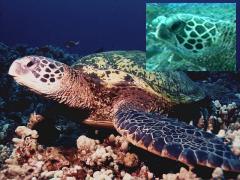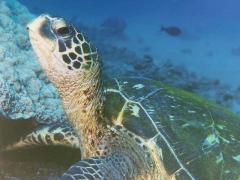Tamu [1995 Turtle 26]
|
|
That was then (inset, 1995) and this is now (2002).
72K JPEG
|
| Quickstats: Seen 1995, 1996 (61K JPEG), 1997 (60K JPEG), 1998 (64K JPEG), 1999 (60K JPEG), 2000 (52K JPEG), 2001 (64K JPEG), 2002. |
Summer updates: 1997, 1998, 1999, 2000, 2001, 2002, 2003, 2004. |
Close inspection of the videotape of our first dive in 1995 confirms we first sighted Tamu on July 2, 1995. It is distant footage of a rather wary turtle swimming away. The shape of her front left flipper is unmistakeable, however, even from that distance.
She is recorded as the 26th turtle of 1995 because it took us that long to get close enough for a photograph good enough to identify her. 1995 Turtle #26 had her comfort distance, and when we got too close she would up and leave. That distance was too great even to determine whether she was healthy. All we could tell was that she was a sub-adult with a munched left flipper.
Each summer we meet new turtles and soon recognize their comfort distance. 1995 #26 needed time to acclimate, so we just ignored her. Over the years, this has been the best way to deal with shy turtles.
Oddly enough, once we ignore them, they get curious about us. It's as though they need to know what kind of creature could possibly find them of no interest. Over several dives they will approach more closely, and when we show up at the Turtle House, they are less prone to leave. Once they acclimate sufficiently, we can get our photos--both left and right profile shots.
Turtle #26 began to accept us. By mid-summer, she was a daily fixture at the Turtle House and went about her business regardless of our presence. That year she was one of the few healthy turtles we saw.
It sobered us, because we believed that if she chose to stay in Honokowai, resting cheek to jowl with mostly tumored turtles--at times she was the only healthy turtle around--she'd likely develop tumors in the next few years.
In 1996, we sighted 95 #26 again on our first dive, June 30th. This time she let us get up close immediately and we got our left and right photos. To our delight she still appeared healthy, although our 1995 logs had stated "2 white spots on right shoulder, left side ok." We were glad to be reminded that white spots don't always mean the beginning of tumors. By July 3rd it was clear that we saw this turtle on every dive and so we decided to name her Tamu.
Oh, you were curious about the name? Well, while working on our comic strip, Turtle Trax Toon, a new character emerged: a cool turtle who held the record for the highest number of tags dating all the way back to 1955. We needed a name. We chose Tamu to honour the Texas A&M University sea turtle webpage, and because people from TAMU are loyal Turtle Trax visitors.
We were both shocked and angered at meeting Tamu this summer. Such is the way with fibropapillomas. Our 1996 logs record "salt and pepper" beside Tamu's photo and it is clear we already suspected he would likely show early tumors for 1997. Sometimes even when there is warning, seeing a good friend worsen doesn't make it any easier.
This summer Tamu had definite eye tumors and a plum sized tumor erupting on his right shoulder. These in themselves would not worry us that much. Turtles have been known to recover from a mild case of fibropapillomas.
On one dive, however, as we were attempting a macro photograph of Tamu's left eye, Tamu became irritated by the intrusion, and rose to leave. In mid-stroke, he gaves us "the flipper" which is a Hawaiian green sea turtle's way of telling humans to stick it. When we got the photo back we were horrified and saddened by what it revealed.
In the corner of Tamu's mouth is a beginning but unmistakeable tumor! Our experience with mouth tumors suggests Tamu is in for a tragic time. Mouth tumors can grow so large they obscure a turtle's facial profile, and they are more than that. Many mouth tumors grow inside the mouth, then distort the turtle's cheeks, giving the impression the animal has stuffed cotton balls in its mouth.
These tumors can grow so big that they cut off any ability for the animal to feed and breathe. We hope Tamu will be spared this fate but with fibropapillomas the news is usually grim. We expect Tamu to be far worse in 1998.
We are happy to report that our concluding statement (above) about Tamu's prospects for 1998 was wrong! The good news is Tamu was not "far worse." In fact, our good friend's condition had improved! The tumor in the left eye had shrunken, as had Tamu's body tumors.
To find any evidence of residual lumps required close inspection. In addition, Tamu seemed to have prospered since the previous summer. He looked as though he'd grown in length and girth. His tail, already long last summer, was now extending past his flippers. Tamu has grown into a handsome male honu.
Not everything is good news, however. We noticed that Tamu is infested with a worrisome new kind of skin barnacle, as yet unidentified. Until we get an identification, we are referring to them as Clingons--because they do.
The Clingon barnacles occupied every possible square centimeter of Tamu's rear haunches. Colonies were also erupting on both shoulders. We've taken careful documention of Tamu's barnacles. If we see him in 1999, we'll be able to detect any changes.
We do expect Tamu to continue his good fortune as far as FP is concerned. We've officially listed him as a regression case. Whether he will be carrrying more barnacles for 1999 is anyone's guess. What factors affect the establishment and growth of skin barnacles are also presently unknown.
Our first Summer 99 sighting of Tamu occurred on July 6th on a morning dive. We found him at one of three scratching posts at the Turtle House. Tamu wasn't scratching, mind you--just hanging out doing as little as possible.
Most of the summer, though, we'd see him at North House--a new turtle congregation area favoured by some of the Honokowai honu.
Tamu continues his good fortune. Close inspection confirmed the absence of any of the tumors he had in previous years. Close-up video work (camera held just centimeters away from the turtle) reveals that Tamu is getting in his foraging time and clearly prospering.
There's more good news: the new type of skin barnacle that we found infesting Tamu last summer appears to have lost some of its foothold on this turtle. This is especially true of Tamu's abdominal colonists.
We fully expect the regression Tamu experienced in 1998 to continue into the year 2000; however, if we don't sight this handsome young male next summer we won't panic. He might choose a migration run to the French Frigate Shoals as his way of celebrating the new millennium!
We sighted Tamu on our July 11th morning dive. He was resting at Mt. Balazs with the adult females U164 and F765, McTaggert.
Imagine. Back in 1995 when we first met, Tamu was a sub-adult sporting the short stubby tail of all young honu--and he had such a cute "baby-face."
In 1995, Tamu had a cute "baby-face"
56K JPEG
|
|
My, has he changed since that first summer! By 2000, five years later, Tamu had developed one of the mildest cases of Fibropapilloma we've ever documented, recovered, and then went on to become an impressive adult male honu.
His shell is spectacular, with splatters and starbursts and flares of greens and golds.
The greatest change, though, is Tamu's face. It's "aged" and darkened, the white spacing between the facial plates narrowing over the years. His face has "put on weight" just like the rest of him. His neck is as thick and wide as any pro-wrestler's.
How fitting to see him for the first time in Summer 2000 in the company of the ladies. It's clear we're not the only ones who see him as a handsome adult male honu!
Great personality too!
We didn't see Tamu until quite late in 2001, August 24th by our records. Based on his shell (spectacularly clean) and his skinniness, we are pretty sure he had just gotten back from his first migration to the French Frigate Shoals. Whenever we saw him, he looked flat out tired and he seemed to want to be left alone to rest. He did let us examine him closely, and as we expected, there is no sign of a return of the mild case of FP that he experienced. Being such a young male, we're not sure whether he'll be around next year, since he might just have the energy to try another migration. We'll see.
Once again Tamu was a late sighting, spotted at North House on August 14th this time. His shell was clean as a whistle and he looked pooped, so we figure he was off courting the ladies again. Such a good-looking turtle should father some rather pretty honu, we think, so we hope he's been having a lot of success. Will he repeat his migration a for a third season? Tune in next summer to find out.
We didn't see Tamu at all this year. He could be late returning from the French Frigate Shoals, or perhaps he's taken after so many of the other young honu that we've seen mature into males: he's left the building. We sure hope not. Tamu is one of our favourites.
Another summer without a sighting of Tamu, so we've had to classify him as one of the Missing. Many of our regulars were not around this summer, and we are not sure what to expect in 2005. We hope to see a bunch of returnees next year, with Tamu among them. Keep your fingers crossed.
Last modified 04/11/06
Send comments or corrections to webmaster@turtles.org

